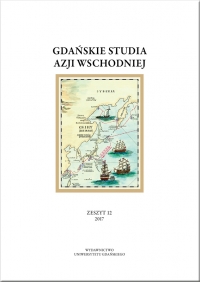Szamanizm w Japonii
Abstrakt
Japanese shamanism is a constantly evolving field of research, despite the fact that its roots still remain mysterious. One of the most common theories states that its nature is secondary, it might be related to tungusic or altai people, spread to Korea, Hokkaido and Ryūkyū Islands, then mixed with Polynesian and Melanesian beliefs, and with time became part of today’s Japanese Buddhism and shintō traditions. The article describes the characteristics of Japanese shamanism: it’s cosmology, silhouette of a shaman, most important myths and practices and also it’s important relation to Japanese theatre.
Shamans act like a bridge between humans, deities and otherworld, and they’re the only living people capable of coming in contact with the dead. In Japan there are two kinds of shaman: female priestess miko and Buddhist ascetic monk yamabushi. Japanese shamanism is one of the rarer examples of female-focused type. They believed only a woman could control the spiritual force. Miko is responsible for performing spirit possessions and fortunetelling. Yamabushi on the other hand was living deep in the mountains and by undergoing a strict training was able to enter trance state. He was close to local people who sought advice from him in many important everyday decisions, as well as regarding special events.
There are also other groups performing shamanistic practices, but they’re considered less authentic, mostly because they don’t have the abilities to experience ecstatic vision or to enter trance state. Among those are, for example: blind mediums itako, kitsunetsukai (fox or snake owners) and onmyōji (in and yo fortunetellers). In the article the Authors attempt to construct an alternative definition of a shaman – because the strictly narrow definition doesn’t seem to reflect the complexity of beliefs found in Japanese culture. Nowadays shamanism is popular among many Japanese new religions and sects, and also had its impact on pop culture, which furthers the impression of how important this subject matter is for Japan.
Downloads
Bibliografia
D. Pollock, Shamanism, Oxford Bibliographies: http://www.oxfordbibliographies.com/view/document/obo-9780199766567/obo-9780199766567-0132.xml (dostęp: 19.11.2017).
M. Ashkenazi, Handbook of Japanese Mythology, Oxford 2008, s. 187.
M. Eliade, Szamanizm i archaiczne techniki ekstazy, tłum. K. Kocjan, Warszawa 2011, s. 346.
D. Barańska, Brak absolutu: pojęcia dobra i zła w japońskiej popkulturze, Kraków 2014.
C. Blacker, The Catalpa Bow: A Study in Shamanistic Practices in Japan, London 1975, s. 17.
M. Wacker, Onarigami Holy Women in the Twentieth Century, „Japanese Journal of Religious Studies” 2003, no. 3–4 (30).
G. Groemer, Female Shamans in Eastern Japan during the Edo Period, „Asian Folklore Studies” 2007, no. 66.
S. Masuo, Chinese Religion and the Formation of Onmyōdō, „Japanese Journal of Religious Studies” 2013, no. 40, vol. 1, s. 19.
I. Hori, Mountains and Their Importance for the Idea of the Other World in Japanese Folk Religion, „History of Religions” 1966, no. 1 (6).
C. Abe, Impurity and Death: A Japanese Perspective, San Francisco 2008.
E. Ohnuki-Tierney, The Monkey as Mirror: Symbolic Transformations in Japanese History and Ritual, Princeton 1989, s. 141–142.
W.P. Fairchild, Shamanism in Japan, „Folklore Studies” 1962, no. 21.
Słownik etnologiczny: terminy ogólne, red. Z. Staszczak, Warszawa 1987.
I. Hori, Folk Religion in Japan. Continuity and Change, Chicago – London 1968.
Kozyra A., Mitologia japońska, Warszawa – Bielsko Biała 2011.
P.R. Sanday, Women at the Center: Life in a Modern Matriarchy, Ithaca, NY 2002.
Nihongi, tłum. W.G Aston, London 1896.
J. Tubielewicz, Mitologia Japonii, Warszawa 1980.
J.E. Kidder, Himiko and Japan’s Elusive Chiefdom of Yamatai: Archaeology, History, and Mythology, Honolulu 2007, s. 9–12.
H. Kosugi, Performative Power of Language: Japanese and Swearing, „Teknosastik” 2010, no. 8.
M. Hane, L. Perez, Premodern Japan: A Historical Survey, New York 2014.
M. Waida, The Patterns of Initiation in Japanese Shamanism, „Anthropos” 1994, no. 89.
K. Sasaki, Spirit Possesion as an Indigenous Religion In Japan and Okinawa, „Senri Ethnological Studies” 1984, no. 11.
J.C. Robinson, Okinawa: A People and Their Gods, Tokyo 1969.
B. Staemmler, Chinkon Kishin: Mediated Spirit Possession in Japanese New Religions, Berlin 2009.
H.B. Earhart, Four Ritual Periods of Haguro Shugendō in Northeastern Japan, „History of Religions” 1965, no. 1 (5).
W. Kotański, Opowieści o pierwszych władcach Japonii, Warszawa 1990.
H. Naitō, Legends of Japan, Tokyo 1972.
L. Hearn, Shadowings, London 1905.
Ueda A., Tales of Moonlight and Rain, New York 2007.
Kojiki, tłum. D.L. Philippi, Princeton – Tokyo 1969.
I. Averbuch, Shamanic Dance in Japan: The Choreography of Possession in Kagura Performance,„Asian Folklore Studies” 1998, no. 2 (57).
M. Melanowicz, Literatura japońska, Warszawa 1994.
K. Kobayashi, On the Meaning of Masked Dances in Kagura, „Asian Folklore Studies” 1981, no. 1 (40).
R. Abraham, Shamanism and Noh, www.ralph-abraham.org/articles/ (dostęp: 12.02.2017).
B. Ortolani, Shamanism in the Origins of the Nō Theatre, „Asian Theatre Journal” 1984, no. 1 (2).

 Uniwersyteckie Czasopisma Naukowe
Uniwersyteckie Czasopisma Naukowe





